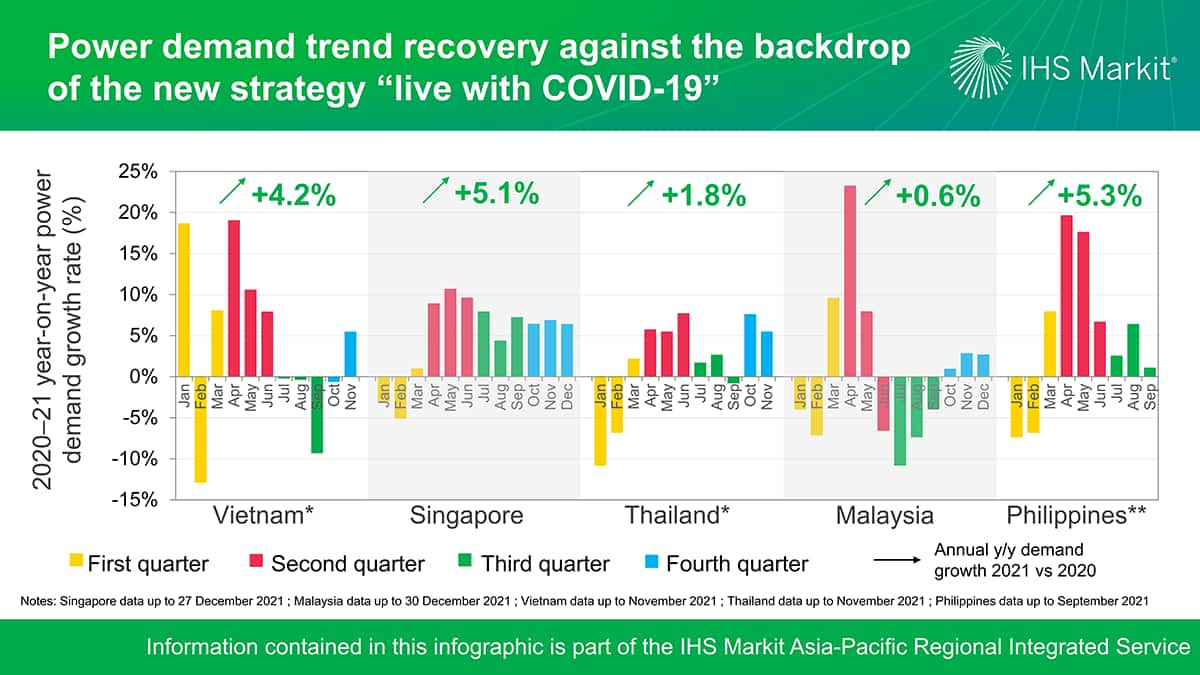The power market slowly rebounded, owing to the reorientation strategy to “live with COVID-19” in the Southeast Asia region
In the fourth quarter of 2021, the power demand slowly rebounded in ASEAN, owing to the reorientation strategy to "live with COVID-19". In addition, the region has witnessed a significant increase in power prices, particularly in Singapore and Malaysia.
According to the published power market statistics, the 2020-21 average year-on-year (y/y) annual power demand growth rate in major Southeast Asian countries varies from 0.6% to 5.3%, indicating a rebound in power demand from 2020 levels. Furthermore, power data for the fourth quarter (Q4) of 2021 (except for the Philippines, where data for Q4 was not available) showed an average growth of 0.6%-5.3%, indicating that the individual nations were successful in moving away from the impact of COVID-19.
Vietnam saw a 0.6% y/y drop in October, but a 5.5% y/y growth in November 2021. The gradual recovery in power demand was due to the "new normal" of living with the pandemic safely and flexibly that Vietnam embraced. The restrictions were gradually eased, and the mass vaccination campaign was launched, resulting in a surge in power demand from November. The rise in power demand was also fueled by factories rushing to complete the pending orders.
Singapore's power demand continues to increase in the Q4 of 2021, with an average y/y growth of 6.6%. This demonstrated that the "living with COVID-19" strategy had been successful in recovering the power market and economy. However, as a country that heavily relies on natural gas for power generation, Singapore's power price climbed by 267% in Q4. This is due to Indonesian gas supplies disruptions, high global LNG prices for replacement fuel, and unplanned power plant maintenance.
Thailand registered a significant increment in power demand by October and November 2021, with an average y/y growth of 6.6%. This indicates that the power market is beginning to recover, as the rising vaccination coverage and the country's approach has moved to "learning to live with COVID-19".
Malaysia's power demand rebounded in the Q4 of 2021 with an average y/y growth of 2.2%, after a severe y/y drop of 7.4% in the previous quarter. This is owing to the ease of COVID-19 restrictions in fully vaccinated business hubs and resumption of interstate travel, as the country join Southeast Asia's "living with COVID-19" campaign. However, Malaysia was dealing with high electricity price as a result of surging coal and gas prices in this quarter.

The full briefing is available for clients only. Clients can read the full briefing here.
Learn more about our research into Asia Pacific energy.
Choon Gek Khoo is a Research Analyst with the Climate and Sustainability group at IHS Markit and focuses on research and data analytics on conventional energy within the Asia Pacific region.
Cecillia Zheng is an associate director with the Climate and Sustainability group at IHS Markit and leads Southeast Asian power market research and consulting.
Posted on 1 February 2022
This article was published by S&P Global Commodity Insights and not by S&P Global Ratings, which is a separately managed division of S&P Global.


